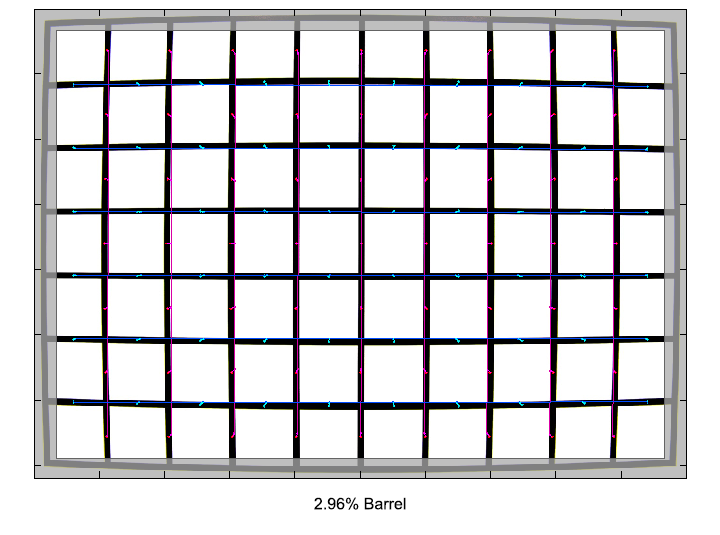|
Page 2 of 3

Distortion
Standard zooms typically show barrel distortion at the shortest focal length, switching to pincushion type distortion towards the upper part of the zoom range. The Nikkor follows this pattern, the magnitude of distortion is surprising, though, with higher amounts than the predecessor.
At 24mm, there is almost 3% of barrel distortion, which soon turns to pincushion type distortion when zooming in. The flipping point (with literally no distortion) is around 30mm. At 35mm, there is a small amount of 0.5%, but zooming in further distortion goes up to 1.6 to 1.7%, which is very noticeably in any shot with straight lines towards the image borders.
|
Move the mouse cursor over the focal length text marks below to observe the respective distortion
|
| 24mm |
35mm |
50mm |
70mm |
|

|
The chart above has a real-world size of about 120x80cm.
Vignetting
The next unpleasant surprise comes with light fall-off. Even though the lens has a bigger front element than the predecessor, the vignetting results are a lot worse.
At 24mm and 35mm there is more vignetting wide open than fits our scale - something we haven't seen in this lens class before. As usual, the amount of light fall-off can be reduced by stopping down, however at 24mm it remains on a fairly high level even at medium and small apertures.
We're performing our vignetting analysis based on
(uncorrected) JPEGs straight from the camera. The JPG engine of the Nikon D3x features a rather flat
gradation curve, thus has a moderate contrast characteristic, resulting in comparatively low vignetting figures - the
corresponding Canon figures are roughly 40% higher due to the more
aggressive default contrast setting.

MTF (resolution)
Let's start with the good news: at 24mm and 35mm, the lens shows excellent center resolution straight from the maximum aperture and very good borders and corners throughout the tested aperture range. In addition, Nikon managed to reduce the amount of field curvature that troubled the non-VR lens. It's still there, but to a lesser degree and not as "curvy" as on the older AF-S 24-70/2.8.
Zooming in to the upper part of the focal range, things look different, though. The center resolution drops considerably at large apertures, but recovers to excellent levels by stopping down (just barely though at 70mm). The borders and corners are still good at the tested apertures at 50mm, but at 70mm they drop another mark at large aperture settings.
In addition to the quite soft border results, the lens shows some focus shift when stopping down, especially towards the long end of the focal range.
Please note that the MTF results are not directly comparable across the different systems!
Below is a simplified summary of the formal findings. The chart shows line widths
per picture height (LW/PH) which can be taken as a measure for sharpness.
If you want to know more about the MTF50 figures you may check out the corresponding
Imatest Explanations

Chromatic Aberrations (CAs)
We're not done with the negative surprises, yet.
Except for the 70mm setting, chromatic aberrations (color shadows at harsh contrast transitions) are surprisingly high, reaching peak values of above 3 pixels at the image borders at 35mm.
Lateral CAs usually can easily be corrected in software or by the camera itself (most modern Nikon DSLRs remove CAs on-the-fly if you shoot JPGs), however CAs this high will have an influence on the perceived sharpness nonetheless.

Bokeh
Being a fast lens and reaching up to 70mm, the lens allows to separate the main subject from the background (for example for portraits). In these kind of shots, one usually aims for a smooth and pleasingly blurred background.
The bokeh the Nikkor delivers is not outstanding, but one of the better ones we've seen from zoom lenses. There is some nervousness both in the transition zone as well as in the background blur.
Background highlights show some outlining and also cat's eye shapes due to mechanical vignetting at large apertures. In addition, they show a minor amount of bokeh fringing at the edges (see next section).

Bokeh Fringing
Bokeh fringing (non-coinciding focal planes of the various colors) is an issue often found on fast lenses, so it's not really surprising that the Nikkor shows some fringing at large apertures, that is reduced to negligible levels stopped down to f/5.6 and beyond.
These images also illustrate the focus shift when stopping down that was mentioned in the MTF section. The issue is emphasized at short focal distances (these shots were close to the minimum focus distance of the lens) and less pronounced, but still noticeable at "regular" shooting distances.
|